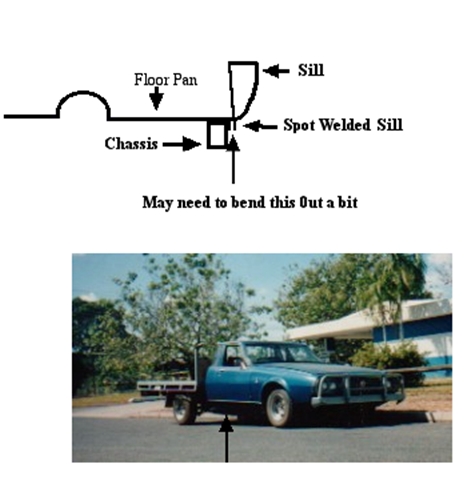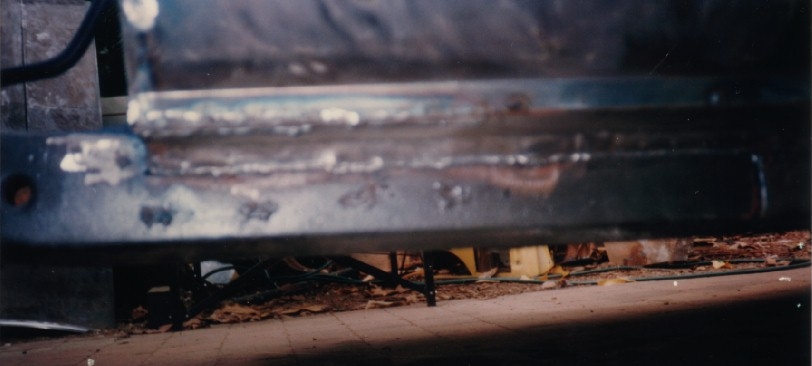Leyland P76 Owners Club of Northern Territory member
The Making of the 'LEYDEN' P76 Tray Back
- From: Barry Levarde
- To: Adrian
- ________________________________________
- Hi Adrian,
- No.... the Leyden was purchased by a "Gunna", ended up rusting away and finally went to the tip..
- I am not too distressed as I built it as a challenge.... drove it twice Darwin/Sydney and the idea worked very well.
- However, it was not what was originally planned... the original was more complicated. I planned to use the rear part of the HG, HQ Holden ute, replace the side skins with P76 outers and make the ute tailgate from a Holden with outer skin from the Leyland boot lid. The ute back is still in m y shed.
- B ecause it was a mixture of Holden & Leyland.... Leyland front, HG Holden rear... I used the Leyland boot letters and coined the name LEY DEN...
- The bullbar was welded up from steel amd exhaust pipe with Leyland front bumper bar corners welded on.
- I will, sort out any pisc I have left and send them.
- Cheers,
- Baz.
What happened
- This project stemmed from an idea I got while touring Tasmania. As a challenge and to give me something to do, I decided to try making a Leyland Ute. It didn’t quite work out the way I wanted it to…. The back half of the project is still in my shed.
- It did however work out quite well and was successfully used for a couple of years until being sold to make way for another project.
- Construction was fairly straight forward, firstly I had to find a chassis from a HJ – HG Holden One Tonner ute or trayback. This chassis will be a tight fit to the Leyland sill plate (inside) You may have to bend the sill plate out a bit with a hammer.

- Diagram 1.

- Photo 2. Showing sill plate welded to chassis
- Next, the chassis has to be cut to the right length. A bit of careful measurement is needed.
- Just behind the rear of the front wheel arch on the floor pan is a square ‘torque box’
- construction. The chassis front edge butts up to this box. The Holden chassis needs to be cut to length just near where the chassis bends in for the front suspension. The chassis is then welded along the sill plate seam and welded to the torque box. (see Photo 2)
- This work has to be done by a "certified welder/engineer" and "documented/certified".
- I shaped the floor pan to the middle chassis cross member and seam welded the two at the middle of the member. This gave room to weld the back to the same point.
- The back of the cabin was a single sheet of 1ml. zincalum welded to a 20ml x 20ml. Rhs frame. Welding was done through a series of 10ml holes lined up with the frame.
- (about 40 in all)

Photo 3
- To get the room for the seats you must cut the body behind the “B” pillar. (see photo 2 above) This is filled in by cutting the rear doors to fit and welding the leading edge to the “B” pillar. Rear quarter window is shaped Perspex but could be sheet metal.
- To save problems, I used a Leyland diff. with the Leyland suspension mounts cut off,
- a little more careful measuring and Holden ‘Spring Plates’ welded on. They must be welded on to stop the diff rotating under acceleration. This allows the use of standard Holden springs which can be beefed up with an extra leaf if needed.. The Leyland and Holden diffs are very similar but doing it this way saved having to alter drive shaft other than for length.
- I actually had a new shaft of bigger diameter made but this wasn’t really needed (over engineering) and caused a later problem of rubbing on the handbrake cable.
- This also saves having odd wheels as the early Holden stud pattern is different to the Leyland.
- For wheels, I used 1970's Ford/Chrysler Peanut mag wheels as they looked more work like and were readily available at the time. They were fitted with 15in light truck tyres.
- This setup allowed the standard P76 instruments to work as accurately as they ever did.
- The tray back was hastily conceived and built to enable attendance at an Easter meet. The original idea was to find a good Holden ute back and cut off the outer skins and replace them with Leyland rear skins.
- I called it a P38 to stir up Hal Moloney he hated that term, but you will note I actually called it a LEYDEN (LEY from Leyland and DEN from Holden). Get the letters from two sets of Leyland boot badges.
- The bullbar was welded up from steel and exhaust pipe with Leyland front bumper bar corners welded on.
- Baz.